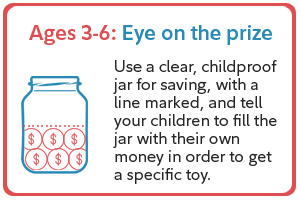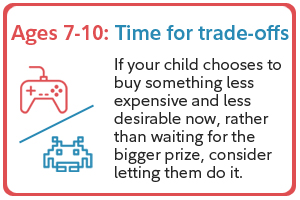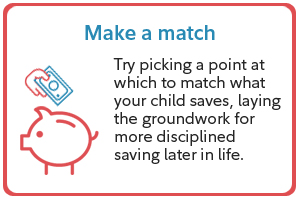Will your children be smart about money? The answer depends a lot on you.
Many people get their money values from their parents, and that's why it can be important for them to teach their children and set an example about money at an early age. "Handing children money without showing them what to do with it can set them up for bigger money mistakes later in life," says Ann Dowd, CFP®, a vice president at Fidelity.
Here are some strategies to instill smart money values for each stage of development:
Ages 3 to 6: Make saving a visual experience
You may think that teaching money values to a 3-year-old is an exercise in futility, but experts suggest otherwise. The more you can "show" children things related to money, the more they'll absorb. "It's very difficult for young children to delay gratification," says Ian Gotlib, David Starr Jordan professor of psychology at Stanford University. "... so you have to be creative about teaching them to save. The key is to make saving visual and very concrete."
With young children, consider having them put money in a piggybank or jar, where they can see it accumulate, or let them use it to buy something. Doing so may help them understand that money can be used to purchase different things they want and need. "Those principles can help build a foundation for more serious saving later on," Gotlib says.

Eye on the prize
Another idea is to use a clear jar for saving, with a line marked on the side. Tell your child to fill the jar up to that line with their money in order to get a specific toy. You could also consider putting a picture of the toy on the jar as an incentive. Each time your child puts money in the jar, they can see their progress. The idea is to connect the buildup of money to the desired toy.
Ages 7 to 10: Learn through trial and error
At this point, children are starting to understand what money can buy, and are learning it's value, but may still need visual aids. You may wish to consider using a savings jar, or multiple savings jars. For example, one for smaller wants, and another for larger items or long-term goals. The use of different jars could assist with goal setting.
Since your kids are starting to learn what things cost, it’s a good time to introduce the idea of "needing enough money". Take your child shopping and talk about how you don’t have enough money to buy an item now, but will be able to purchase it after you save more. "Kids learn by modeling what their parents do, so if you can model a delay in spending, they’ll get the message," says Gotlib.

Time for trade-offs
Try letting your children experience "not having enough money yet" on their own. Let them pick something special at a store, something they can’t afford, and demonstrate that in three weeks, for example, if they save their entire allowance, the item they want can then be purchased. If your child chooses to buy something less expensive and less desirable now, rather than waiting for the bigger prize—consider allowing the purchase. This can be a valuable lesson in trade-offs: If you spend now rather than save, you might not get what you really want later.
Ages 11 to 14: Show a variety of purposes for money
By this time, children are generally old enough to understand that money can have multiple uses such as streaming services, hobby lessons, music downloads, or going out with friends.
Try teaching the value of money through a “bucketing strategy.” This means putting a certain amount of money away for different purposes. They might have short-term goals such as buying a new phone or buying a gift for a friend, and longer-term goals like saving for a laptop. "A bucketing strategy can help you teach that saving isn’t meant for ‘leftover’ money," Dowd says. It may be helpful to sit together and plan how much of your child’s money (whether it’s their allowance or what they’ve earned) will go into each bucket, then put each bucket in a good place.
You could also consider opening a savings account for your child, although in some instances you may need to be a joint owner until they’re old enough to own it alone. To keep savings growing, your child could make a habit of putting at least part of any money received for birthdays, holidays, and special occasions into a savings account. Earned money from chores, could also be put into a savings account or another short-term option.
Make a match
Reward good saving habits! Children of all ages and young teens may not find saving as rewarding as spending, so try picking a point at which to match what your child saves. For example, if their goal is to save $20, you could add an additional amount to the savings once that goal is reached. This could lay the groundwork for more disciplined savings later in life when they reach adulthood, for example, contributing to employer matching contributions through a 401(k) plan.

Ages 15 to 17: Keep track
With college or trade school possibly on the horizon, setting a foundation for budgeting could be advantageous. While children may not be financially independent in high-school, they will likely have to manage their own money to a certain extent. An after-school or weekend job could help. "Kids may be more careful with what they’ve earned than with money that is just handed to them," says Gotlib.
If your teen begins to earn income, you may wish to consider opening a Roth IRA for Kids, which can be a good tool for saving for retirement or even their first-home purchase. However, keep in mind, contributions can’t exceed the teen’s earning's or annual limit set by the IRS, whichever is less. Although there's no minimum age to open a Roth IRA for Kids, they do need to be earning income of their own.
Keep it simple. Help your teen write a list of what they have to pay for with their money, and assign a cost to each item (gas, clothing, entertainment). Split the list into needs and wants. Then, have them try living on what they have budgeted for to help them understand and experience the importance of budgeting, the different purposes of money, and outcomes of overspending or under-saving.

Try new tools
High school kids are tech savvy, so put budgeting on their terms. Help set up an online budget they can track, and adjust with a click of the mouse. Create a simple budget spreadsheet showing your child’s income and expenses, and have them track their spending each month, as they spend and save.
You could also consider opening a Fidelity Youth® Account.


